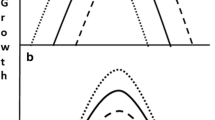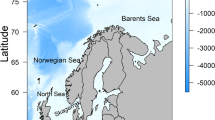Summary
How do organisms adapt to the differences in temperature and length of the growing season that occur with latitude? Among Atlantic silversides (Menidia menidia) along the east coast of North America, the length of the first growing season declines by a factor of about 2.5 with increasing latitude. Yet body size at the end of the first growing season does not decline. High-latitude fish must, therefore, grow faster within the growing season than do low-latitude fish. This geographical pattern has a genetic basis. Laboratory experiments on fish from six different locations revealed a latitudinal gradient in the capacity for growth (i.e., maximum growth potential). In two subsequent experiments using fish from Nova Scotia (NS), New York (NY) and South Carolina (SC) that had been separately reared in a common environment for several generations, differences in growth rate among populations were highly significant. The rank order was NS>NY>SC, but the difference among populations depended on temperature. High-latitude fish outperformed those from low latitudes primarily at the high temperatures that low-latitude fish would be expected to experience most often in nature. These results suggest that instead of being adapted for growth at low temperatures, fish from high latitudes are adapted for rapid elevation of growth rate during the brief interval of the year when high temperatures occur. Selection on growth rate results from sizedependent winter mortality: the importance to winter survival of being large increases with latitude but the length of the growing season simultaneously decreases. The end result is countergradient variation in growth rate, a phenomenon that may be much more widespread than currently recognized.
Similar content being viewed by others
References
Adams SM, McLean RB, Huffman MM (1982) Structuring of a predator population through temperature-mediated effects on prey availability. Can J Fish Aquat Sci 39: 1175–1184
Ament A (1979) Geographic variation in relation to life history in three species of the marine gastropod genus Crepidula: growth rates of newly hatched larvae and juveniles. In Stancyk SE (ed) Reproductive ecology of marine invertebrates. University of South Carolina Press, Columbia, pp 61–76
Anderson WD Jr, Dias JK, Dias RK, Cupka DM, Chamberlain NA (1977) The macrofauna of the surf zone off Folly Beach, South Carolina. U.S. Dept Comm, Nat Mar Fish Serv, Special Sci Rep Fish No 704
Austin HM, Amish R (1974) Preoperational ecological monitoring program of the marine environs at the Long Island Lighting Company Shoreham nuclear power station, Shoreham, Long Island, N.Y., Vol III Fishery ecology. Long Island Lighting Co, Hicksville, New York, USA
Austin HM, Dickinson J, Hickey C (1973) An ecological study of the ichthyofauna at the Northport power station, Long Island, N.Y. Long Island Lighting Co, Hicksville, New York, USA
Barkman RC, Bengston DA, Beck AD (1981) Daily growth of the juvenile fish (Menidia menidia) in the natural habitat compared with juveniles reared in the laboratory. Rapp R-v Reun Cons Int Explor Mer 178: 324–326
Bayliff WH (1950) The life history of the Atlantic silverside, Menidia menidia (L.). Chesapeake Biological Laboratory, Solomons Island, Maryland, Publ 90
Bengston DA (1984) Resource partitioning by Menidia menidia and Menidia beryllina (Osteichthyes: Atherinidae). Mar Ecol Prog Ser 18: 21–30
Berven KA, Gill DE, Smith-Gill SJ (1979) Countergradient selection in the green frog, Rana clamitans. Evolution 33: 609–623
Boyce MS (1979) Seasonality and patterns of natural selection for life histories. Am Nat 114: 569–583
Bullock TH (1955) Compensation for temperature in the metabolism and activity of poikilotherms. Biol Rev 30: 311–342
Cadigan KM, Fell PE (1985) Reproduction, growth, and feeding habits of Menidia menidia (Atherinidae) in a tidal marsh-estuarine system in southern New England. Copeia 1985: 21–26
Clarke A (1987) Temperature, latitude and reproductive effort. Mar Ecol Prog Ser 38: 89–99
Conover DO (1984) Adaptive significance of temperature-dependent sex determination in a fish. Am Nat 123: 297–313
Conover DO (1985) Field and laboratory assessment of patterns in fecundity of a multiple spawning fish: the Atlantic silverside, Menidia menidia. Fish Bull U.S. 83: 331–341
Conover DO (1990) The relation between the capacity for growth and length of the growing season: evidence and implications of countergradient variation. Trans Am Fish Soc (in press)
Conover DO, Fleisher MH (1986) Temperature-sensitive period of sex determination in the Atlantic silverside, Menidia menidia. Can J Fish Aquat Sci 43: 514–520
Conover DO, Heins SW (1987) Adaptive variation in environmental and genetic sex determination in a fish. Nature 326: 496–498
Conover DO, Kynard BE (1984) Field and laboratory observations of spawning periodicity and behavior of a northern population of the Atlantic silverside, Menidia menidia (Pisces: Atherinidae). Env Biol Fishes 11: 161–171
Conover DO, Murawski SA (1982) Offshore winter migration of the Atlantic silverside, Menidia menidia. Fish Bull U.S. 80: 145–149
Conover DO, Ross MR (1982) Patterns in seasonal abundance, growth, and biomass of the Atlantic silverside, Menidia menidia, in a New England estuary. Estuaries 5: 275–286
Cossins AR, Bowler K (1987) Temperature biology of animals. Chapman and Hall, London
Cushing DH (1975) Marine ecology and fisheries. Cambridge Univ Press, Cambridge
Daborn GR, O'Neill JT, Williams RRG (1979) Limnology of the Annapolis River and estuary II. Fish distributions in the estuary, 1976 and 1977. Proc Nova Scotia Inst Sci 29: 173–183
Dehnel PH (1955) Rates of growth of gastropods as a function of latitude. Physiol Zool 28: 115–144
Henderson PA, Holmes RHA, Bamber RN (1988) Size-selective overwintering mortality in the sand smelt, Atherina boyeri Risso, and its role in population regulation. J Fish Biol 33: 221–233
Hildebrand SF (1922) Notes on habits and development of eggs and larvae of the silversides, Menidia menidia and Menidia beryllina. Bull U.S. Bur Fish 38: 113–120
Hunt RL (1969) Overwinter survival of wild fingerling brook trout in Lawrence Creek, Wisconsin. J Fish Res Board Can 26: 1473–1483
Isely JJ, Noble RL, Koppelman JB, Philipp DP (1987) Spawning period and first-year growth of northern, Florida, and intergrade stocks of largemouth bass. Trans Am Fish Soc 116: 757–762
Jessop BM (1983) Aspects of the life history of the Atlantic silverside (Menidia menidia) of the Annapolis River, Nova Scotia. Can Manu Rep Fish Aquat Sci No 1694
Jessop BM, Morantz DL (1982) A survey of the Atlantic silverside fishery of Prince Edward Island. Can Manu Rep Fish Aquat Sci No 1639
Johnson MS (1975) Biochemical systematics of the atherinid genus Menidia. Copeia 1975: 662–691
Kendall WC (1902) Notes on the silversides of the genus Menidia of the east coast of the United States, with descriptions of two new subspecies. Rep U.S. Comm Fish Fisheries, No 1901 Pt 17: 241–267
Lasker R (ed) (1981) Marine fish larvae. Washington Sea Grant, Univ Washington Press, Seattle, Washington, USA
Levins R (1969) Thermal acclimation and heat resistance in Drosophila species. Am Nat 103: 483–499
Levinton JS (1983) The latitudinal compensation hypothesis: growth data and a model of latitudinal growth differentiation based upon energy budgets. I. Interspecific comparison of Ophryotrocha (Polychaeta: Dorvilleidae). Biol Bull 165: 686–698
Levinton JS, Monahon RK (1983) The latitudinal compensation hypothesis: growth data and a model of latitudinal growth differentiation based upon energy budgets. II. Intraspecific comparisons between subspecies of Ophryotrocha puerlis (Polychaeta: Dorvilleidae). Biol Bull 165: 699–707
Lindsey CC (1966) Body sizes of poikilotherm vertebrates at different latitudes. Evolution 20: 456–465
Lindstedt SL, Boyce MS (1985) Seasonality, fasting endurance, and body size in mammals. Am Nat 125: 873–878
Lonsdale DJ, Levinton JS (1985) Latitudinal differentiation in copepod growth: an adaptation to temperature. Ecology 66: 1397–1407
Mayr E (1963) Populations, species, and evolution. Belknap Press, Cambridge, Massachusetts, USA
Middaugh DP (1981) Reproductive ecology and spawning periodicity of the Atlantic silverside, Menidia menidia (Pisces: Atherinidae). Copeia 1981: 766–776
Modde T, Scalet CG (1985) Latitudinal growth effects on predatorprey interactions between largemouth bass and bluegills in ponds. N Am J Fish Manage 5: 227–232
Needler AWH (1940) A preliminary list of the fishes of Malpeque Bay. Proc Nova Scotia Inst Sci 20: 33–41
Ogburn MV, Allen DM, Michener WK (1988) Fishes, shrimps, and crabs of the North Inlet estuary, SC: A four-year seine and trawl survey. Baruch Inst Tech Rep 88-1. Univ. South Carolina, Columbia, South Carolina, U.S.A.
Oliver JD, Holeton GF, Chua KF (1979) Overwinter mortality of fingerling smallmouth bass in relation to size, relative energy stores, and environmental temperature. Trans Am Fish Soc 108: 130–136
Ray C (1960) The application of Bergmann's and Allen's rules to the poikilotherms. J Morph 106: 85–108
Schneider DE (1967) An evaluation of temperature adaptations in latitudinally separated populations of the xanthid crab, Rhithropanopeus harrisii (Gould) by rearing experiments. PhD thesis, Duke University, Durham, North Carolina, USA
Shuter BJ, MacLean JA, Fry FEJ, Regier HA (1980) Stochastic simulation of temperature effects in first-year survival of smallmouth bass. Trans Am Fish Soc 109: 1–34
Sverdrup HU, Johnson MW, Fleming RH (1942) The oceans: their physics, chemistry, and general biology. Prentice-Hall Inc, Englewood Cliffs, New Jersey, USA
Toneys ML, Coble DW (1979) Size-related, first winter mortality of freshwater fishes. Trans Am Fish Soc 108: 415–419
Vouglitois JJ (1983) The ichthyofauna of Barnegat Bay, New Jersey — Relationships between long term temperature fluctuations and the population dynamics and life history of temperate estuarine fishes during a five year period, 1976–1980. MS thesis, Rutgers University, New Brunswick, New Jersey, USA
Warkentine BE, Rachlin JW (1987) Age and growth of 0+ year class Menidia menidia. Ann New York Acad Sci 494: 438–440
Williamson JH (1986) An evaluation of Florida, northern, and hybrid largemouth bass, Micropterus salmoides, under intensive culture conditions. PhD thesis, Texas A&M University, College Station, Texas, USA
Author information
Authors and Affiliations
Rights and permissions
About this article
Cite this article
Conover, D.O., Present, T.M.C. Countergradient variation in growth rate: compensation for length of the growing season among Atlantic silversides from different latitudes. Oecologia 83, 316–324 (1990). https://doi.org/10.1007/BF00317554
Received:
Accepted:
Issue Date:
DOI: https://doi.org/10.1007/BF00317554




